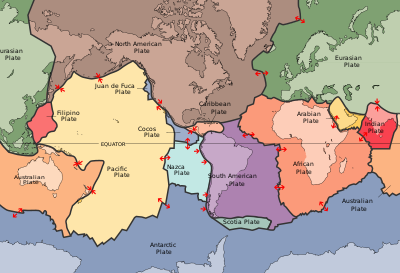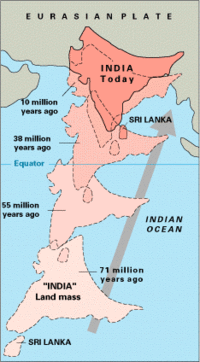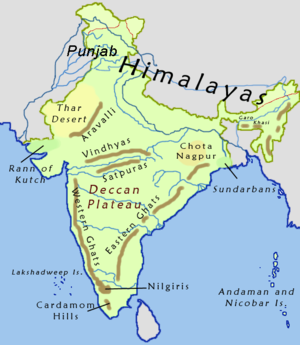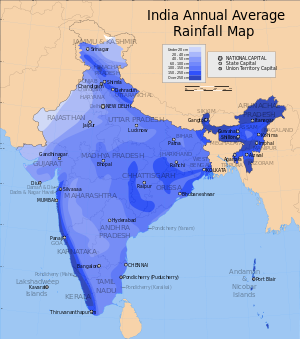GEN101:Geography and climate of India
Let us first talk about the geographical features of India. As we all are well aware, the geography and climate of a region influences the biota of that region. Latitudinal species gradients are well-known examples of geography affecting biodiversity. For instance, there are 7 species of ants in Alaska, 63 in Utah, 101 in Cuba and 222 in Brazil[1][2]. Similarly, in Michigan, USA there are ~10-15 species of deciduous trees per hectare, while in Malaysian tropical rainforests, there are 227 species per hectare [1]. These examples suggest that knowing the geography and climate of a region is the first step in understanding the source of its biodiversity.
Contents
Preliminary readings
Overview
Much of India's biodiversity stems from its diverse geographical landscape. The nation is bound by the Arabian Sea in West and South-west and the Bay of Bengal in the East. These two seas, which mingle freely with the Indian Ocean in the South, bring moisture into the country through their channel currents. At the north, the country is bound by the vast Himalayan (हिमालय) mountain ranges (Him/हिम meaning snow and आलय/alaya meaning abode). India also shares many of its geographical features (and thus the biodiversity) with many neighboring nations including Sri Lanka, Myanmar, Bangladesh, Nepal, Bhutan, China and Pakistan.
Origins of India
India is entirely contained on the Indian plate, a major tectonic plate that was formed when it split off from the ancient continent Gondwanaland. About 90 million years ago, during the late Cretaceous Period, the Indian Plate began moving north at about 15 cm/yr (6 in/yr)[3]. About 50 to 55 million years ago,in the Eocene epoch of the Cenozoic Era, the plate collided with Asia after covering a distance of 2000-3000km|, having moved faster than any other known plate. In 2007, German geologists determined that the reason the India Plate moved so quickly is that it is only half as thick as the other plates which formerly constituted Gondwanaland.[4] The collision with the Eurasian Plate along the modern border between India and Nepal formed the orogenic belt that created the Tibetan plateau and the Himalayas. As of 2009, The India Plate is moving northeast at 5 cm/yr (2 in/yr), while the Eurasian Plate is moving north at only 2 cm/yr (0.8 in/yr). India is thus referred to as the "fastest continent."[4] This is causing the Eurasian Plate to deform, and the India Plate to compress at a rate of 4 mm/yr (0.15 in/yr).[5]
The December 26, 2004 earthquake in the Indian Ocean, which gave rise to the massive tsunami, was caused by the continuing motion of the Indian Plate. A thrust-faulting event due to a 100 km (60 mi) rupture caused about 1,600 km (994 mi) of the interface to slip, which moved the fault 15 m (50 ft) and lifted the sea floor several meters, creating the great tsunami.
The fact that India was once joined with Africa is also evident in the species diversity in India. Many species, such as the plant species Catharanthus roseus and Marsilea minuta, are indigenous to both India and Madagascar. The separation of India and Madagascar is traditionally estimated to have taken place about 88 million years ago.
Distinctive landforms
Generally speaking, the land of India can be divided into seven regions:
- The northern Himalayan mountain ranges
- The Indo-Gangetic plain
- The Thar Desert
- Central Highlands and the Deccan Plateau
- Mainland mountain ranges, which includes ranges shown in the picture alongside
- East Coast
- West Coast
- Bordering seas and islands
Of these regions, the Western Ghats, the Himalayas and the Indo-Gangetic plain contain a significant amount of biodiversity that is experiencing strong population pressure. Many of the endangered or threatened species in India, such as the Gharial, the Ganges Dolphin, Indian elephant etc. lie in these habitats.
Habitats and ecoregions
Based on different classification systems, India can be divided into different regions. However, the system most important for conservation purposes is the Global 200. Global 200 is a set of worldwide ecoregions that have been identified as critical for conservation purposes. This system of classification was developed by World Wildlife Fund (WWF) in 1995 and actually consists of 867 terrestrial and aquatic habitats. Of those 238 - 142 terrestrial, 53 freshwater, and 43 marine ecoregions - were selected for focused conservation efforts.
On a more broader scale, India lies in the Indomalayan ecozone. This zone extends from Afghanistan and Pakistan through the Indian subcontinent andSoutheast Asia to lowland southern China, and through Indonesia as far as Java, Bali, and Borneo. Indomalaya also includes the Philippines, lowland Taiwan, and Japan's Ryukyu Islands.
According to the Global 200 system, India is divided into 11 biomes comprising of 43 different ecoregions. For a full list of the biomes and the ecoregions, go to the following page:
List of ecoregions in India
The conservation strategy in each of these ecoregions would vary.
Climate
Main article: Climate of India on Wikipedia.
The climate of India defies easy generalization, comprising a wide range of weather conditions across a large geographic scale and varied topography. Analyzed according to the Köppen system, India hosts six major climatic subtypes, ranging from desert in the west, to alpine tundra and glaciers in the north, to humid tropical regions supporting rain forests in the southwest and the island territories. Many regions have starkly different micro climates. The nation has four seasons: winter (January and February), summer (March to May), a monsoon (rainy) season (June to September), and a post-monsoon period (October to December).
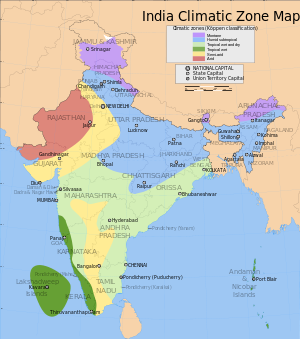
India's unique geography and geology strongly influence its climate; this is particularly true of the Himalayas in the north and the Thar Desert in the northwest. The Himalayas act as a barrier to the frigid katabatic winds flowing down from Central Asia. Thus, North India is kept warm or only mildly cold during winter; in summer, the same phenomenon makes India relatively hot. Although the Tropic of Cancer—the boundary between the tropics and subtropics—passes through the middle of India, the whole country is considered to be tropical.
This is primarily due to the Himalayas. The formation of the Himalayas resulted in blockage of frigid Central Asian air, preventing it from reaching India; this made its climate significantly warmer and more tropical in character than it would otherwise have been.[6]
According to the Köppen system, India has six climatic zones:
- Montane
- Humid subtropical
- Tropical wet and dry
- Tropical wet
- Semi-arid
- Arid
Biodiversity is most abundant in the Montane, Humid subtropical and the Tropical wet climatic zones.
Influence of climate and geography on biodiversity
India occupies 2.4% of the world's land area and supports over 17.5% of the world's population. India has more arable land area than any country except the United States,[7] and more water area than any country except Canada and the United States.
Suggested readings
Exercises
References
- ^ a b Charles Krebs. Ecology: The Experimental Analysis of Distribution and Abundance. ISBN 9780321042897.
- ^ Google Knol on Latitudinal Gradients in Species Diversity
- ^ Bin Zhu et al. (PDF). Age of Initiation of the India-Asia Collision in the East-Central Himalaya. Department of Earth and Atmospheric Sciences, University at Albany. pp. 281.
- ^ a b Dr. Rainer Kind (September 2007). The Fastest Continent: India's truncated lithospheric roots. Helmholtz Association of German Research Centres.
- ^ Wikipedia entry on Geography of India
- ^ Water Resources of India: Physio graphic Conditions, Publisher:Ministry of Water Resources (Government of India)
- ^ GM Crops Around the World – an accurate picture GM Freeze, Table 3
